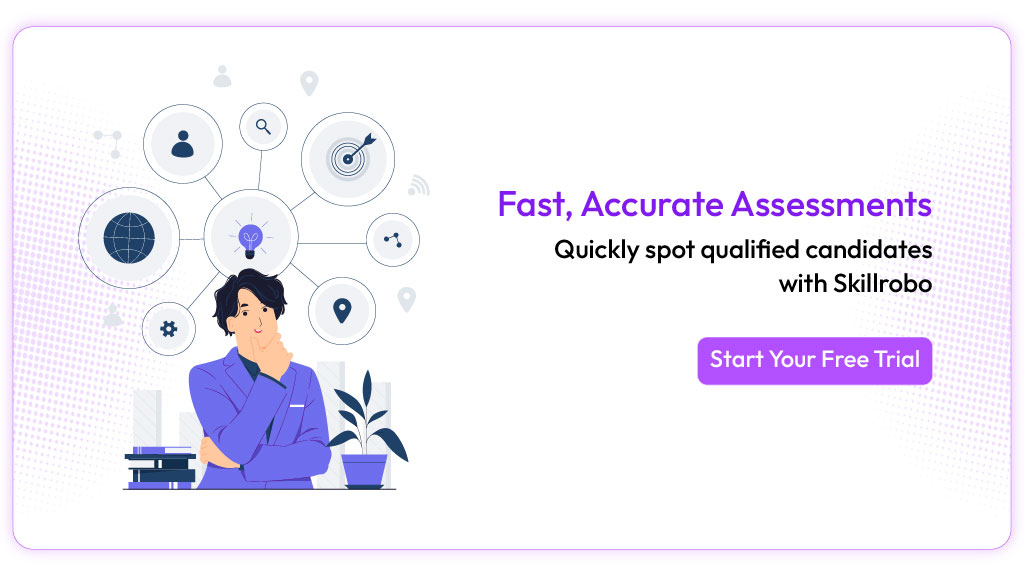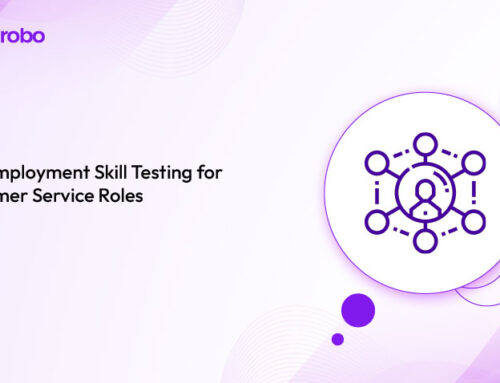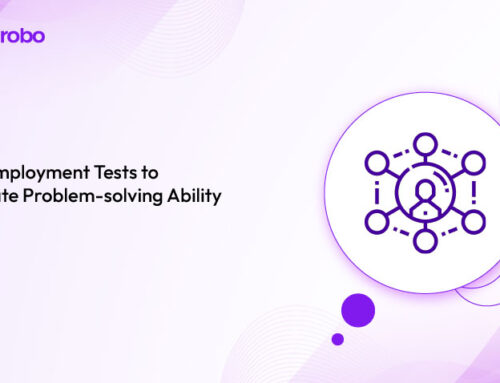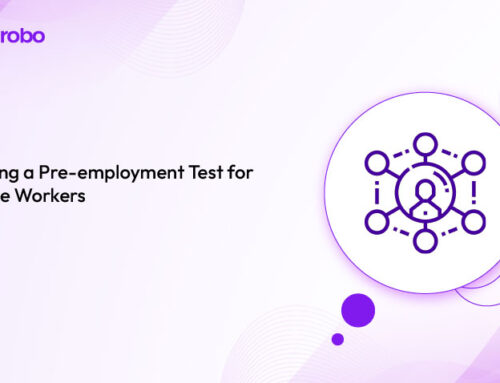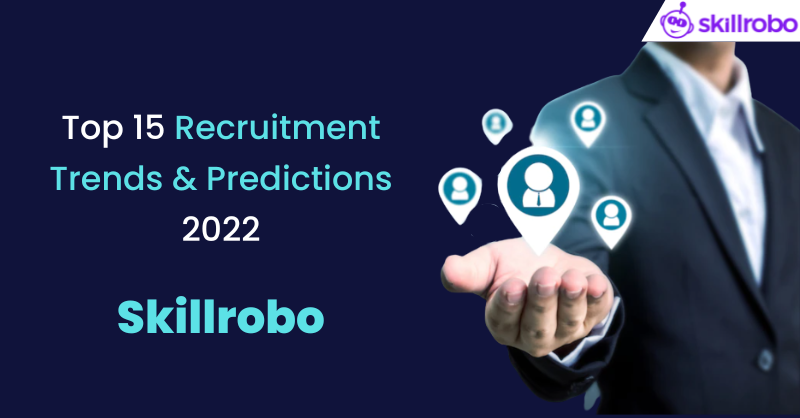
Key Takeaways
- Recruitment trends and predictions highlight a shift toward skill-first, tech-driven hiring models.
- Remote work and flexible hiring strategies are reshaping talent acquisition trends globally.
- Automation and AI tools streamline repetitive tasks, improving recruiter efficiency and candidate experience.
- Platforms like Skillrobo help organizations future-proof hiring through customized assessments and secure online testing.
Why Recruitment is Rapidly Evolving
Recruitment today isn’t just about posting jobs and scheduling interviews—it’s about creating future-ready teams that can thrive in a dynamic, tech-driven world. Traditional hiring methods are being replaced by more agile, skill-centric, and technology-enabled approaches.
Key factors like the widespread adoption of remote work, the rise of AI and automation, and shifting candidate expectations are pushing organizations to rethink how they attract, assess, and hire talent. Flexibility, speed, and personalization have become critical components of a successful recruitment strategy.
Moreover, companies that fail to adapt to the future of recruitment in 2025 risk losing the battle for top talent. Staying informed about the latest recruitment trends and predictions gives businesses a strategic advantage—ensuring they not only fill roles efficiently but also build resilient, diverse, and future-proof teams.
In this blog, we’ll dive into the major trends driving the evolution of hiring practices and show how you can leverage modern tools and strategies to stay ahead in a competitive talent market.
Setting the Stage: What’s Driving the Future of Recruitment?
Several powerful forces are converging to reshape how organizations attract, assess, and retain talent. Rapid technological advancements, growing remote work opportunities, and the demand for a more diverse and skilled workforce are all pushing companies to rethink traditional hiring models. To stay competitive, businesses must move beyond outdated methods and embrace smarter, faster, and fairer recruitment strategies.
Let’s take a closer look at the key recruitment trends and predictions shaping the future of hiring—and how you can start implementing them today.
1. Skills-First Hiring Takes Center Stage
One of the most transformative shifts in recruitment today is the pivot toward skills-first hiring. Rather than focusing on where a candidate went to school or which companies they previously worked for, organizations now prioritize demonstrated competencies and practical abilities.
Why it Matters: Research consistently shows that skills-based hiring broadens talent pools, enhances workplace diversity, and improves overall job performance. It allows companies to look beyond traditional markers of success like pedigree, which can often introduce bias. Skills-based approaches open doors to talented individuals who may have taken non-traditional paths but bring immense value.
Impact:
- Companies hire for potential, not prestige, reducing reliance on degrees or big-brand companies.
- Upskilling and reskilling initiatives become long-term HR priorities to grow talent internally.
- Recruitment becomes more equitable, inclusive, and focused on real potential.
Example: Leading tech firms now evaluate candidates based on customized skill assessments rather than focusing exclusively on Ivy League credentials or fancy job titles. The focus is shifting to “what you can do” rather than “where you’ve been.”
Tip: Using a platform like Skillrobo’s pre-employment skills tests helps objectively measure candidate skills early in the hiring funnel. This approach ensures that only the most capable candidates progress through the recruitment stages.
2. AI and Automation in Recruitment
Artificial Intelligence (AI) and automation have become essential to modern recruitment processes. These technologies are transforming how recruiters source, screen, and engage candidates by taking over repetitive, time-consuming tasks.
Why it Matters: Automation saves time, reduces human error, and allows recruiters to focus on strategic activities like relationship-building.
Impact:
- Faster time-to-hire as mundane tasks are automated.
- Improved candidate experience with timely updates, personalized messaging, and smoother application processes.
- Data-driven hiring decisions through predictive analytics and AI-generated candidate scoring.
Example: Many companies now use AI chatbots to conduct first-level candidate screenings. These bots handle FAQs, collect preliminary data, and schedule interviews—freeing recruiters to focus on high-value interactions with qualified applicants.
Tip: To fully understand the benefits and potential downsides of recruitment automation, explore the insights shared in the pros and cons of recruitment methods. Striking the right balance between automation and human touch is key to successful hiring.
3. Remote Hiring Becomes the Norm
The COVID-19 pandemic didn’t just introduce remote work; it accelerated a massive shift toward remote hiring as a permanent part of HR operations. Organizations now hire, onboard, and manage employees across countries and time zones as a standard practice.
Why it Matters: Remote hiring dramatically expands the talent pool, allowing organizations to tap into global expertise. It fosters diversity, promotes work-life balance, and reduces office space and related operational costs. However, it also demands new approaches to recruitment and onboarding.
Impact:
- Companies implement asynchronous interview processes where candidates can respond to questions on their own time.
- Assessing remote work readiness becomes a standard part of candidate evaluations, focusing on communication skills, self-discipline, and tech-savviness.
- Remote-first companies are more agile, diverse, and scalable.
Example: Global firms like Zapier and GitLab have embraced fully remote models, building high-performing teams that span continents. They rely heavily on structured, remote-first hiring processes to ensure cultural fit and skill alignment.
Tip: For effective and secure remote hiring, it’s critical to use online assessment systems with anti-cheating features like browser lockdowns and AI monitoring. These tools ensure candidate integrity even when hiring remotely.
4. Diversity, Equity, and Inclusion (DEI) Gain Momentum
Diversity, Equity, and Inclusion (DEI) are no longer “nice-to-have” initiatives—they are core business strategies. Companies that prioritize DEI see stronger innovation, better decision-making, and higher profitability.
Why it Matters: According to McKinsey’s Diversity Wins report, companies with higher gender diversity on executive teams were 25% more likely to experience above-average profitability. Diversity isn’t just ethical—it’s profitable.
Impact:
- Organizations are implementing blind hiring practices and using structured interviews to minimize bias.
- Inclusive job descriptions and targeted outreach help tap into underrepresented talent pools, creating richer and more dynamic workforces.
Example: Global giants like Accenture and Salesforce have integrated DEI into their core business values. They regularly publish detailed DEI reports and hold leadership accountable for diversity targets.
Tip: Integrate structured behavioral assessments early in hiring to ensure fair evaluations and prevent unconscious bias. To understand risks related to favoritism, explore this blog on favoritism at work.
5. Data-Driven Hiring Decisions
Intuition alone doesn’t cut it anymore in recruitment. While gut feelings and personal impressions once played a large role in hiring, today’s competitive and complex job market demands a more structured, objective approach. Data-driven hiring is the future, empowering HR teams to make smarter, faster, and more accurate decisions based on evidence—not instinct.
Why it Matters: By leveraging data such as candidate skills assessments, sourcing metrics, interview performance analytics, and post-hire success rates, companies can optimize every stage of the hiring funnel. Recruiters can identify what sourcing channels yield the best candidates, which assessment scores predict high performers, and where bottlenecks occur in the process.
Impact:
- Improve quality of hire by predicting future performance based on measurable traits.
- Reduce time-to-hire by focusing efforts on the most effective sourcing and screening strategies.
- Enhance diversity and inclusion by minimizing unconscious biases through standardized evaluation criteria.
Example: Companies like IBM use talent intelligence platforms to predict candidate success, helping them reduce turnover and improve new hire performance.
Tip: Capture candidate data and analytics from platforms like Skillrobo to benchmark applicants effectively and continuously improve your hiring process.
6. Focus on Candidate Experience
The candidate experience is the new battleground for attracting and retaining top talent. In today’s competitive hiring environment, a poor experience can turn away highly qualified candidates—even if you extend them a generous offer at the end.
Why it Matters: A report from CareerBuilder found that 68% of candidates believe the way they are treated during the hiring process reflects how the company treats its employees internally. In short, the recruitment experience sets the tone for employer branding, engagement, and employee loyalty.
Impact:
- Leading organizations now map every step of the candidate experience—from application to final offer.
- Tailored messages and prompt updates at every stage make candidates feel valued and respected.
Example: Companies like Spotify and HubSpot lead the way by offering transparent, fast-moving hiring processes. They keep candidates informed, offer feedback promptly, and create a positive experience—even for those who aren’t selected. This attention to detail helps secure top candidates before competitors even conclude initial interviews.
Tip: Learn how using different types of assessment methods enhances candidate experience. Structured assessments not only make the process fair but also provide candidates clarity about what skills are valued.
7. Cognitive and Behavioral Assessments Rise
While technical expertise can help candidates land a job, it’s their behavioral and cognitive skills that drive long-term success. That’s why recruiters increasingly value a balanced evaluation covering both hard and soft skills.
Why it Matters: Soft skills such as problem-solving, adaptability, critical thinking, and team collaboration have become essential, especially in remote and hybrid work environments. In these settings, employees must self-manage, communicate clearly, and make independent decisions without constant supervision.
Impact:
- Organizations that assess behavioral and cognitive skills early hire candidates who align better with company values.
- Companies can identify future leaders early by focusing on high-potential cognitive and behavioral traits rather than just experience or seniority.
Example: Forward-thinking employers are increasingly using tools like situational judgment tests and cognitive aptitude assessments to simulate real-world scenarios and evaluate how candidates react. These tests measure not just what candidates know, but how they apply knowledge in practical settings.
Tip: Choose the right cognitive tools for your hiring process with this breakdown of cognitive tests to ensure you’re selecting candidates who can adapt, problem-solve, and thrive in dynamic workplaces.
8. Upskilling and Internal Mobility Prioritized
Hiring externally can be expensive, time-consuming, and risky. That’s why leading organizations are now heavily investing in their existing workforce through structured upskilling and internal mobility programs.
Why it Matters: Internal promotions cost less, address skills gaps faster, and significantly boost employee engagement and loyalty. Employees who see growth opportunities within the company are more likely to stay, reducing turnover and increasing institutional knowledge.
Impact:
- Companies are rolling out dedicated platforms for employee learning and skill development.
- Instead of static career ladders, employees can now move laterally across departments, reskilling into new, in-demand roles like data analysis, digital marketing, or project management.
Example: Amazon has pledged $1.2 billion to upskill 300,000 employees by 2025 under its Upskilling 2025 initiative. They focus on teaching employees tech-driven skills to prepare them for higher-paying, future-ready roles within or outside the company.
Tip: Support your internal mobility goals by using Skillrobo’s competency assessment tools to identify hidden talent and develop future leaders based on real competencies, not just tenure.
9. Employer Branding Shapes Talent Attraction
Candidates today research employers just as carefully as consumers research products. Your employer brand—how your company is perceived as a workplace—has a direct impact on your ability to attract and retain top talent.
Why it Matters: A strong employer brand reduces cost-per-hire, shortens time-to-hire, and improves offer acceptance rates. Organizations with strong brands attract 50% more qualified candidates (LinkedIn data).
Impact:
- Companies are investing in real, employee-generated content showcasing culture, career growth, diversity, and day-to-day work life.
- Businesses encourage employees to share positive workplace experiences on platforms like LinkedIn and Glassdoor, amplifying the brand’s reach.
Example: HubSpot and Salesforce consistently rank among the best workplaces globally by actively promoting their transparent, inclusive, and empowering work cultures across all digital touchpoints.
Tip: Make your hiring process transparent and candidate-friendly. Use structured assessments early on, such as behavioral assessment tools, to ensure fairness and reinforce your company’s reputation for valuing talent objectively.
10. Hybrid Work Models Create New Hiring Playbooks
The global shift to hybrid work has completely changed how companies hire, manage, and retain employees. Flexible work is now expected, not just a perk.
Why it Matters: While hybrid work offers flexibility, it also brings new challenges like maintaining collaboration, communication, and accountability across dispersed teams. Hiring strategies must evolve to assess readiness for hybrid environments.
Impact:
- Recruiters now evaluate candidates on technical skills and soft skills like self-motivation, time management, and asynchronous communication.
- Organizations are investing in training programs to equip both managers and team members to succeed in hybrid settings
Example: Microsoft’s hybrid workplace strategy emphasizes flexible work arrangements combined with hybrid onboarding programs and investment in collaboration technologies like Teams and Viva to bridge the gap between remote and in-office employees.
Tip: Use technical and behavioral assessments early in the hiring process to ensure candidates are equipped for hybrid setups. You can also evaluate adaptability traits using trusted behavioral assessment tools to ensure success in both remote and in-person settings.
How Skillrobo Helps You Stay Ahead of Recruitment Trends
Staying competitive in today’s fast-changing recruitment landscape requires the right tools—and that’s where Skillrobo comes in.
Skillrobo is an AI-powered assessment platform that helps companies future-proof their hiring strategies by blending skills-based hiring with advanced analytics and automation.
Here’s how Skillrobo aligns with the latest recruitment trends:
1. Skills-First Hiring:
Skillrobo offers 100+ customizable pre-employment skills tests—covering technical, cognitive, communication, and behavioral competencies. You can objectively measure candidates’ real abilities early in the funnel.
2. Behavioral and Cognitive Assessments:
Go beyond hard skills. With behavioral assessments and cognitive aptitude tests, you can evaluate soft skills like teamwork, adaptability, and leadership potential—crucial for hybrid and remote teams.
3. Secure Online Testing:
Skillrobo’s AI-powered anti-cheating features—including browser lockdowns, randomized questions, and webcam monitoring—ensure fair and credible remote assessments.
4. Automation and AI Insights:
Instant scoring, detailed analytics, and candidate benchmarking help recruiters make faster, data-driven decisions—reducing time-to-hire and improving hiring quality.
5. Remote Hiring Enablement:
Whether you’re hiring globally or assessing remote candidates, Skillrobo’s mobile-friendly, secure platform lets candidates complete assessments from anywhere.
Conclusion: Future-Proof Your Hiring Strategy
Recruitment trends and predictions show that skills-first, tech-enabled, and data-driven hiring will dominate the future. Companies that embrace these changes will build stronger, more adaptable teams ready for whatever the future holds.
Platforms like Skillrobo empower organizations to hire smarter by offering customizable, secure assessments tailored to modern hiring needs.
Ready to revolutionize your hiring strategy? Explore and sign up on Skillrobo today!
Frequently Answered Questions
1. What are the key recruitment trends shaping 2025?
Skills-first hiring, remote recruitment, DEI initiatives, and recruitment automation are key trends defining future hiring landscapes.
2. Why is data-driven hiring important?
It removes the guesswork, improves decision-making, and allows organizations to optimize recruitment pipelines based on performance metrics.
3. How can companies improve candidate experience?
By maintaining clear communication, offering structured assessments, and providing timely feedback during the hiring process.
4. What role does AI play in modern recruitment?
AI streamlines sourcing, screening, and engagement, allowing recruiters to focus on building relationships rather than manual tasks.
5. How does Skillrobo support future-ready hiring?
Skillrobo offers secure, customizable online assessments and behavioral testing tools to help companies hire faster, smarter, and more fairly.

